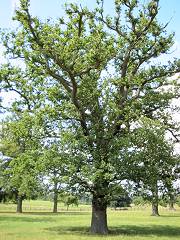 1920s
1920sDuring the early 1920s acute dieback of mature woodland oak first aroused widespread concern in England. Damage was thought to begin with the defoliation of trees in early summer by caterpillars of the oak leaf roller moth (Tortrix viridana), an insect which was very abundant in the years after the end of World War 1.
By 1924 there were reports of oaks were dying in alarming numbers in certain sections of the defoliated woods. However, just a year later many of the sickly oaks showed an improvement in condition, and this improvement coincided with a marked reduction in the moth.
By the late 1920s, there were no further reports of oak dieback for over 30 years.
In 1958 death of young pedunculate oak occurred in several woods near the Norfolk coast, but adjacent sessile oak was unaffected. Drought and exposure were thought to be important triggers of decline, together with the effects of defoliating insects and mildew.
There were also accounts of damage in the early 1980s in Surrey and in the Forest of Dean.
However, it was not until around 1989 that another episode of serious oak decline started to have an impact over a 3- to 4-year period. Trees reported to be most affected were in the Midlands and southern England and ranged from 40 to 200 years of age. Approximately half were in woodland and half were in parkland, but the majority of the trees were pedunculate oak. At some of the affected sites up to a quarter of the trees had dieback symptoms or died from oak decline.